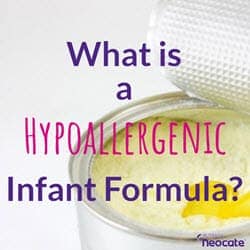 What is a Hypoallergenic Formula? Most consumers today believe that a product labeled as hypoallergenic will not cause an allergic reaction, but is this true?
What is a Hypoallergenic Formula? Most consumers today believe that a product labeled as hypoallergenic will not cause an allergic reaction, but is this true?
Let’s start with the basics. The technical definition of “hypoallergenic” is that a product is less likely to cause an allergic reaction. Or: will cause fewer allergic reactions. Few federal standards regulate the use of this term for consumer goods.
For infant formulas, however, you can rest assured that the term “hypoallergenic” meets specific criteria.
What is a Hypoallergenic Infant Formula?
When it comes to infant formulas, based on calls our nutrition specialists get regularly; many people think hypoallergenic ensures that no allergens are present. The reality is more complex.
For an infant formula to have “hypoallergenic” on the label, it needs a clinical trial. According to the American Academy of Pediatrics (AAP), hypoallergenic infant formula must be:
- Studied in a clinical trial
- Studied in children with confirmed cow milk allergy
- Tolerated by at least 90% of the patients
“Tolerated” means that the formula did not cause an allergic reaction. That means a patient in the trial had no symptoms or signs of allergic reactions (e.g. hives, anaphylaxis, etc.). Only formulas made of free amino acids – like Neocate – or extensively hydrolyzed proteins are hypoallergenic.
Other types of formulas in the US are NOT hypoallergenic. These include formulas made with whole dairy protein, with soy protein, or with partially hydrolyzed protein. Formulas also aren’t hypoallergenic if they haven’t been studied in a clinical trial!
Difference Between a Hydrolyzed Formula and Amino Acid-Based Formula
Hydrolyzed formulas are made using protein from dairy (or soy), but the milk proteins in those formulas have been broken down into small fragments. The body’s immune system may not detect the smaller protein fragments as being an allergen. However, in some patients with a cow milk allergy, the body still reacts to the protein fragments in extensively hydrolyzed formula. This results in allergic reactions.
Amino acid-based formulas, also known as elemental formulas, use only amino acids as the source of protein. Amino acids are the building blocks of protein and are too small for the body to recognize as being foreign. They are a non-allergenic option that replaces protein and peptides.
To help you visualize the difference between these two types of formulas, picture a pearl necklace. The process of hydrolysis is like breaking the necklace into smaller segments with some pearls attached. These pieces are the peptides used in hydrolyzed formulas. Even shorter strands of fewer “beads” are like the shorter peptides used in an extensively hydrolyzed formula.
If you start with individual pearls, then you have an idea of amino acids. In an amino acid-based formula like Neocate, the amino acids are not in chains together. Neocate has synthetic amino acids instead of those from meat or dairy. These amino acids are mostly made from plant sugars, and some are entirely synthetic.
Here’s another way to look at infant formulas and their potential for triggering an allergic reaction:

Can a Child React to a Hypoallergenic Infant Formula?
It is possible for a child with food allergies react to formulas made with hydrolyzed protein, or peptides. Amino acid-based formulas, on the other hand, are the least allergenic type of formula. That’s because they’re least likely to cause a food allergy reaction. That’s because the amino acids are non-allergenic.
Now you know that two types of infant formulas can claim to be hypoallergenic. And you can see that the term alone doesn’t guarantee that there will NOT be an allergic reaction. The healthcare team should guide you to the right hypoallergenic formula for your child – amino acid-based or extensively hydrolyzed.
Here are some additional resources that can be helpful if you are currently evaluating various formula types:
- What Makes Neocate Special? An Overview of Different Types of Baby Formulas
- Hydrolyzed Formulas vs. Neocate: When to Change
Last updated July 2020






